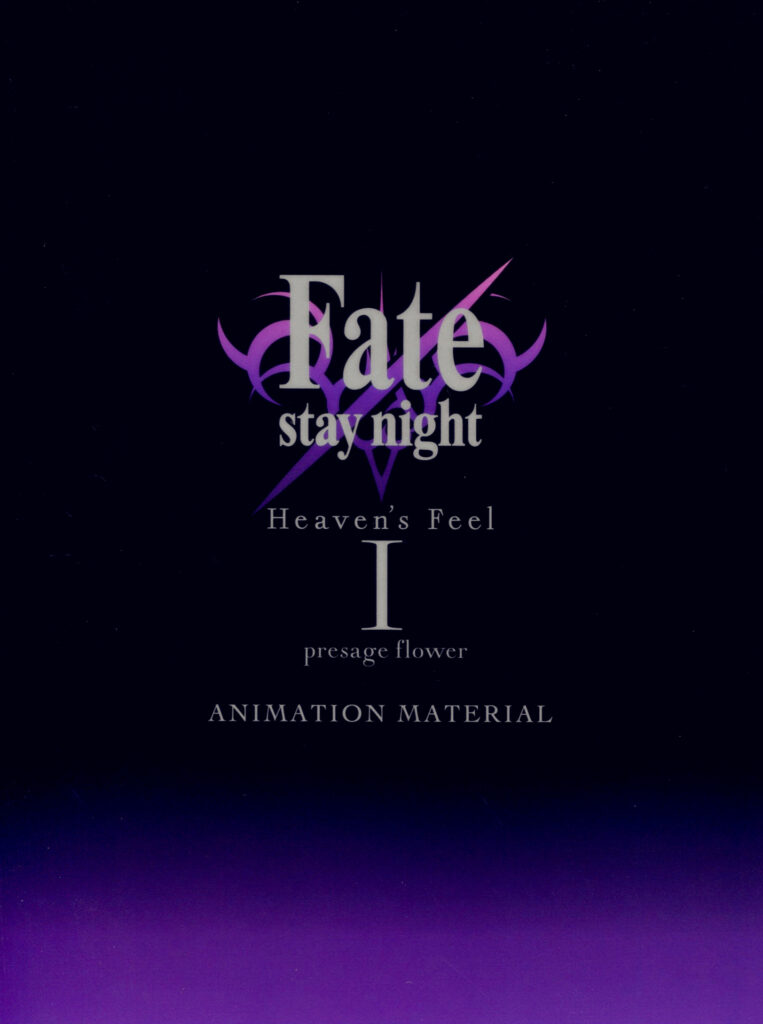
Editor’s Note: The official translations were riddled with errors regarding grammar and spelling, which were kept for the sake of posterity. The booklet was also not completely translated as the English release removed over 10 pages from the original Japanese version. These pages are included at the bottom of the article.
Director Interview
Tomonori SUDO
THEME 1: Coming across TYPE-MOON titles
Q: The announcement for the movie version of Fate/stay night [Heaven’s Feel] (hereafter noted as [HF]) was announced during the “Fate Project Newest Information Disclosure” in 2014. It’s been roughly three years since. When did you start feeling that the first chapter was getting complete?
Sudo: A premiere showing for the industry was planned for Machi*Asobi Vol.19 in Tokushima Prefecture (October 7, 2017) so we finished the film with that as the target date. I believe it was when the domestic release date came and went without Issues was when I really felt like It was done.
Q: What were the days like during the three years of production?
Sudo: I basically focused on the title I am in charge of at the moment. For instance, when I was working on Fate/stay night [Unlimited Blade Works], I gave it everything as an animation director. However, when I had some free time, I was thinking about [HF] in the back of my mind. It was something I had been thinking about all along from the time I first bought the original Fate/stay night game. Occasionally, when I thought about [HF], images popped up inside my head. It feels like I was banking all of those, bit by bit.
Q: I heard you have been playing TYPE-MOON titles even before Fate/stay night. How did you come across TYPE-MOON titles?
Sudo: I first found out about them on the Internet. Back then, there weren’t any illustration portal websites like there are now, so everyone looked at the personal homepages of artists you particularly liked. While doing so, I had the opportunity to come across illustrations of characters that were especially charming. As I was looking at them I wondered, “Who is this boy with the glasses? Who is this blonde girl?” I learned I could purchase the original title where those characters made an appearance at a game shop in Akihabara. That was how I got a hold of Tsukihime, and that was how I came across TYPE-MOON titles. I finished every route and played the fan disc Kagetsu Tohya too. I’m not that good at fighting games, but I finished MELTY BLOOD as well.
THEME 2: What has been inherited from the directorial debut piece to the present
Q: What parts of the original Fate/stay night game did you find interesting?
Sudo: The music, the art, the world view… I felt everything was interesting. Nasu’s titles, such as Tsukihime, Fate/stay night, and DDD all have plot developments where a human living in urban areas come across something phantasmal that existed in the underside of society. I was a fan of fantastical works of that nature to begin with.
Q: You became seriously involved with TYPE-MOON titles from the movie series the Garden of sinners. Can you tell us a bit about –recalled out summer– which you were the director for?
Sudo: I received an offer from our president (producer Hikaru Kondo) on whether I wanted to “try out being a director.” However, I had not done any directing before, so I requested to be a director for a TV series before I worked on –recalled out summer-. That is how I got to work on A Wicked Beast’s Roar, episode 5 of Fate/Zero.
Q: Are there parts of your directorial experience from the Garden of Sinners -recalled out summer- that you are utilizing to this day?
Sudo: The biggest part, I think, is “how I think as a director.” After my first directorial piece, I felt that it was difficult to relay your intentions to other people, and I learned just how profound directing was. Therefore, I think about being able to properly explain the intentions I have for each scene. I want to become better at controlling “time” and “momentum” so that the audience can further enjoy it as a movie.
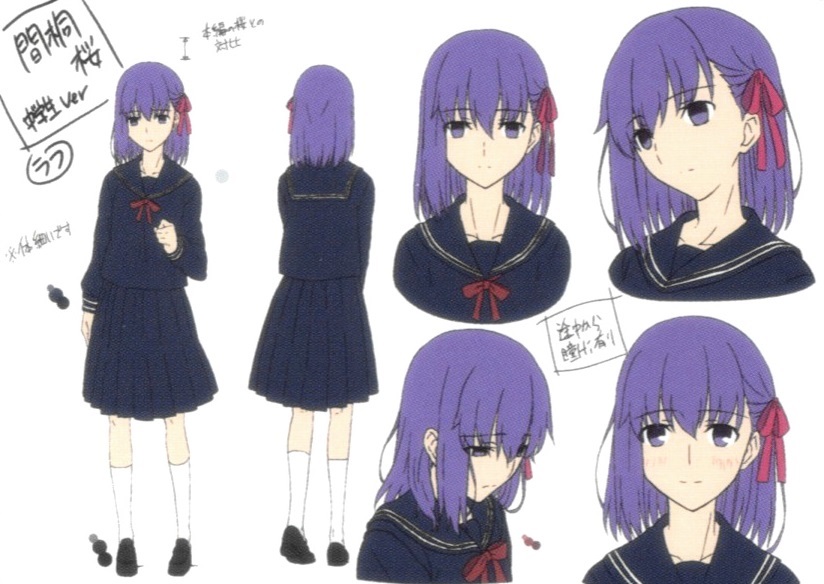
THEME 3: The meaning and changes involved in making Fate/stay night now
Q: In making the movies for [HF], did you go back and play the original Fate/stay night game or Fate/stay night [Réalta Nua]?
Sudo: I did. I played every element of [Réalta Nua] that had changed in the PC version for verification. In the production of [HF], I tried to weigh in the impressions I personally had back when I was playing the original games. I received the original text data from TYPE-MOON as production reference material, but when I was reading parts of the text data, I sometimes got a feeling that was different from when I was playing the original games. When I analyzed this phenomenon, I believe I felt like that because the Fate universe had expanded in the dozen or so years, and all of that is a part of my memories.
Q: Which means, the impressions you had when you played the original game are tied in with your current feelings.
Sudo: In animating [HF], I read the original text and imagined how the characters were feeling and thinking in that scene as I organized the visual image. I combined my impressions I had back then with the impressions I have now, all the while keeping in mind to make it enjoyable for the audience.
This piece not only portrayed the original game, but also had elements from the subsequent fan-disc Fate/hollow ataraxia.
Sudo: Fate/stay night was released in 2004 and has compiled its world view and characters’ natures in the dozen or so years that followed. I feel that [HF] was an anime movie that was created after all those years have passed. If [HF] was an anime back in 2004, I believe each character would have been drawn in a different light. In return, I believe that if [HF] were to be created 10 years from now, it would also be drawn differently than the present.
Q: Saber Alter making an appearance at the end of chapter 1 was a surprise.
Sudo: Black Saber (Saber Alter) is a character from the Fate/stay night timeline, differing from Fate/hollow ataraxia and beyond. She is drawn merely as another side of Saber. It’s like your other self is staring at you. I don’t think this particular setup is something I would have thought of a dozen or so years ago.
Q: How was the production scene at ufotable this time around?
Sudo: I feel that I was able to work in a really wonderful environment. For instance, the art director (Koji) Eto offered his ideas one after another, so that was very helpful. I had given very abstract requests like, “make it a feeling like dry air” or “high skies in winter,” but he managed to manifest them into art, and I am really grateful for that. Also, the director of photography (Yuichi) Terao and the 3D director (Kazuki) Nishiwaki were able to express things that could not be done by a CG such as “a transport truck tearing down into pieces after colliding into an expressway wall.” And for this piece, the color settings and the finishers really put in a lot of effort. There are scenes where a single cut showed time elapsing, and so having them create character shading — depending on the season, time, and even where or not there is lighting — was really good for a theatrical piece.
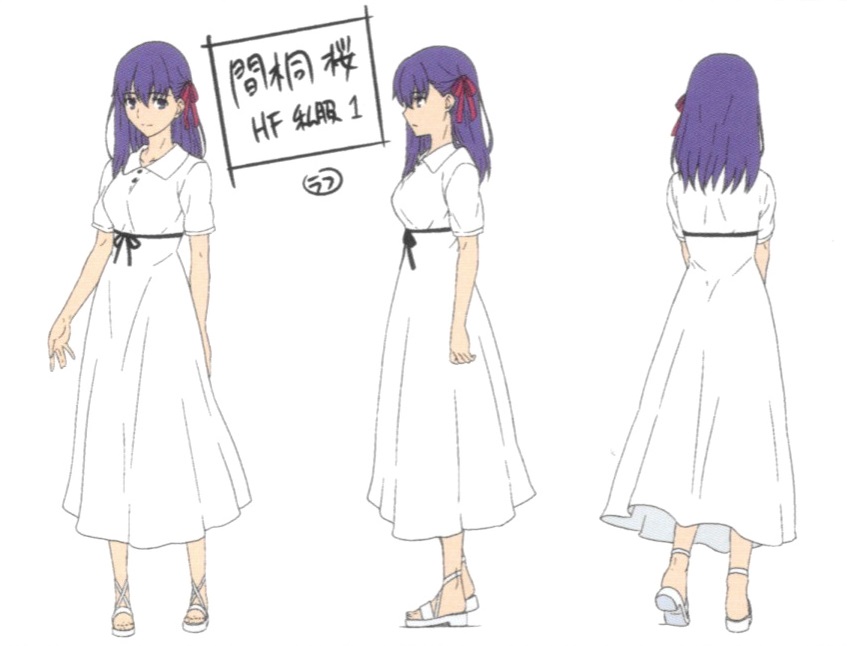
Q: Lastly, please tell us what you got out of Chapter 1, and what you aspire to do in Chapter 2?
Sudo: There were parts of chapter 1 I felt had some trial and error, but I was glad that we were able to draw a peaceful everyday life at the prologue. It was huge that we were able to tell the audience that “this is going to be a story about Shirou and Sakura.” In visual media, I believe that the atmosphere (sense of air) created by a piece is important, but it’s very difficult. This time around, we were able to set the atmosphere of [HF] during the prologue. Using the experiences we learned in Chapter 1, we are going to do our best in producing a Chapter 2 that can live up to everyone’s expectations.
The Emiyas Special Crosstalk
Noriaka SUGIYAMA x Noriko SHITAYA x Miki ITO
Fate/stay night [Heaven’s Feel] the movie I. presage flower – Special Emiya Family Discussion
“Fate/stay night is a piece where the cast’s voice type and acting—the actors’ characteristics—were accurately encapsulated in the casting.”
THEME 1: Feelings towards the characters met a dozen or so years ago
Q: We gathered all of you as you play characters that hang out at the Emiya residence. First off, how did you first get involved with the Fate series? What was your “encounter” with Fate/stay night roughly ten years ago?
Ito: I remember well when I auditioned for the role of Taiga (Fujimura). I went to the audition studio and introduced myself in the staff room. Koji Tsujitani, the sound director back then (for the 2006 TV anime version of Fate/stay night) told me lightheartedly, “Miki, just do what you always do.” Nut when you work long as a voice actor, you start to lose sight of what exactly you “always do.” I wasn’t sure what my usual self was, but since I had to enter the studio right away to do a voice recording, I decided to just read the lines based on my initial impression on-site. When I did, I heard laughter from the booth, and Tsujitani said, “Just like that.” And I kept going with no criticism (correction requests), and the audition ended. I heard laughter and I didn’t get any criticism, so I thought I didn’t get the part. But later I learned I got the part. I felt that not being self-conscious was my “natural state.” Taiga is someone who hangs around in the living room, and she isn’t involved in any of the battles, so even after the recordings started I didn’t get worked up and simply showed my “true self.” But I never imagined this title would go on for such a long time, let alone that it would be drawn out on such a vast scale.
Shitaya: I also remember my audition. I was auditioning for the roles of Saber and Sakura Matou. Sakura’s audition lines were chats with Shirou (Emiya) and everyday life scenes…I think? I don’t remember agonizing over thet lines, but I didn’t think I would get the part either. As for Saber, I felt that I just wasn’t it… (laughs). Later, when I heard (Ayako) Kawasumi acting as Saber, I thought, “That’s Saber!!”
Sugiyama: I only auditioned for the role of Shirou, and I had the chance to act out lines from both everyday life and battle scenes. Of the several scenes I recorded, there was a scene where I was told that my “opponent in battle is Saber, and I had to fight against a girl I harbored feelings for.”
Q: That’s a memorable scene for those who played [Heaven’s Feel] in the original game.
Sugiyama: That’s right. And afterwards, I received word that I had gotten the part. When I was doing the actual recording, I was thinking about acting out Shirou more like in a foreign film than an anime. Shirou is a character that’s “harder to read” than other characters, even in the everyday life segments. I felt that such a nuance would be expressed better by creating (an act) like a foreign film.
Ito: True. It’s hard to figure out what Shirou is thinking (laughs). I (Taiga) am his foster sister, but still can’t get a grasp of Shirou. But then again, Shirou is molded like that thanks to the acting plans laid out by Sugiyama.
Sugiyama: It’s great if it’s working well. And the fact that Shirou doesn’t show his true emotions is why Shinji (Matou) gets irritated.
Ito: It had been a while since I saw Shinji and I thought, what a despicable guy (laughs)! For both Shirou and Shinji, the fact that people’s emotions get swayed just by watching this piece is all based on the actors’ strengths.
Sugiyama: Fate/stay night is a piece where the cast’s voice type and acting–the actors’ characteristics–were accurately encapsulated in the casting. I think that’s something we can all be very grateful for.
Shitaya: It’s unbelievable to think that everything started from our auditions.
THEME 2: Taiga’s cheerfulness saved Shirou and Sakura
Q: What kind of impressions do you have of Taiga, Sugiyama?
Sugiyama: During the piece, she is a fixture to the warm everyday life scenes, and her existence brightens up the Emiya household. When Ito does whatever she wants in her acting, she occasionally gets requests to “tone it down a bit more,” but personally I would have liked to see Fuji-nee (Taiga) like that more often.
Ito: Taiga has all sorts of funny scenes, like in the “Tiger Dojo.” Stuff like that matches well with my nature (laughs). But when we go back to the main story, I still play around… I just feel like something is lacking when I’m acting serious.
Sugiyama: In Chapter 1, there was a request to “calm down a bit more” during the Christmas scene.
Ito: It was a scene where Taiga was drunk, but I had a request to “don’t drink so much (don’t overdo the drunken acting).” That’s a bad sign.
Sugiyama: (Kinoko) Nasu writes stories that have a huge gap between the serious and comical scenes, so when you’re trying to express it with your voice, sometimes that gap just gets too big. The same goes for Shirou too. I try to hold bad as much as possible, but if I hold back too much, it doesn’t end up being a comical scene at all.
Q: The relationship between Shirou and Taiga is a curious one.
Sugiyama: Fuji-nee knows of Kiritsugu (Emiya, Shirou’s adoptive father) from when he was alive, and Shirou himself feels like Taiga is like an older sister to him. But that sibling-like distance starts to disappear as Shirou matures into a young man. Despite that, when Fuji-nee gets captured by Caster in [Unlimited Blade Works], Shirou acts in desperation. It becomes clear that Fuji-nee is very human as well.
Ito: I try not to think about it too much, but I know that Taiga must also have many feelings towards Shirou. But Taiga is naturally cheerful, so I feel like she’ll overcome any hardships of raising someone with no blood relations (Shirou) as her family. I may be feeling this way because I am currently raising a child of my own, but I feel like it’s easier to understand how girls feel because I’m a woman. But boys are a different story. Taiga probably doesn’t understand everything about Shirou either. Despite that, Taiga tries to act cheerful around Shirou. There’s this term called “koshoku (eating alone)” where someone eats by themselves, and I think that’s really lonely. I think Taiga is acting cheerfully in her small world between her family and school so that Shirou doesn’t have to feel things like that.
Q: What kind of impressions do you have of Taiga, Shitaya?
Shitaya: The fact that Sakura, who had closed herself up, is able to smile and have light return to her eyes, is not just because of Shirou, but also because of Ms. Fujimura. A family gathering around the dinner table and laughing as they eat a meal was something that Sakura was never able to do. Though it may not be shown in the show, Sakura must have learned so much from Ms. Fujimura, and so I feel like she is someone dear to Sakura.
Ito: Taiga is a teacher, and she’s seen all sorts of students, so she must have felt, “This girl (Sakura) is different from the normal kids.” But she never shows that out in the open and she trusts Shirou to do what he needs to do to save her. I think she planned on watching over in the background from the very beginning.
Q: In Chapter 1, the story starts a year and a half before Shirou and Taiga first meet Sakura. By doing so, everyday life in the Emiya household is drawn pretty solidly.
THEME 3: Fuji-nee is the symbol of happiness within Fate/stay night
Ito: I was really happy that they drew everyday life for Shirou and I in the opening scenes. Shirou may be a master when he’s outside, but even he has somewhere warm, a home, to return to. I earnestly think that things like that are cherished by both the viewers and the production staff.
Shitaya: It ended up getting cut during the edit, but there was a scene where Sakura walks along the street in the rain getting wet before she first visits the Emiya household. Sakura in that scene left an impression on me. I kept wondering what Sakura was thinking as she walked along when I acted the middle school Sakura. I believe that the first encounter scene was an absolute necessity.
Sugiyama: When Sakura came to the Emiya household, it was raining. The weather reflected Sakura’s current emotions, and that’s why the lights from the Emiya house feels so warm. That feeling left a lasting impression. Fuji-nee seemed to be the symbol of happiness, even. Later on, Shirou fights with a sword throughout the Holy Grail War, but I believe he was able to do so because of Fuji-nee. I feel the foundation was surely formed when Fuji-nee trained him at the dojo when he was young.
Ito: If that’s true, then I’m happy. Once the Holy Grail War starts, Taiga has absolutely no scenes at all, but if the setting is something like that (a dojo), she might be able to earn the seat of a main character someday. In other words, I’m totally looking forward to “Tiger Dojo” becoming its own anime!

Q: Lastly, please tell us your feelings for [HF] Chapter 2.
Shitaya: At this point in time, I have no idea how Chapter 2 will turn out. Thanks to Director Sudo’s arrangement, Chapter 1 followed the story of the original game, yet had many scenes that presented a new perspective. I’m looking forward to the story of Chapter 2, and as an actor, I would like to make sure I do a solid performance.
Ito: Chapter 1 was very refreshing, so I think I will be able to approach the next chapter in a new light as well. I’ve received many responses and letters from all sorts of people, which reiterated to me that Fate/stay night really is popular. In order to meet everyone’s expectations, I would like to work my hardest through purity, honesty, cheerfulness, and brightness!
Sugiyama: I may be redundant to those who have seen the movie, but I want everyone to have high hopes for ufotable’s super amazing quality footage. I’m sure everyone’s reactions have reached the people at ufotable, and their stance is to keep working on their material until they are completely satisfied. I hope to do my best so that we too can meet those expectations, making it an even better title than it is already.
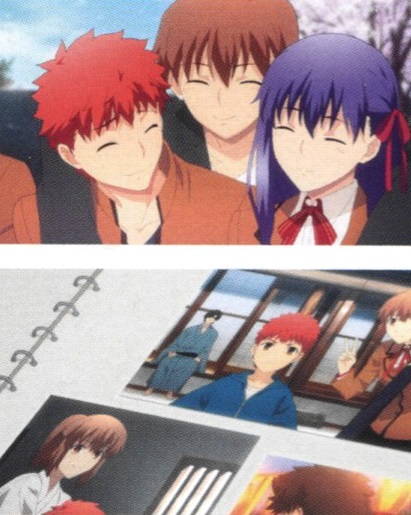
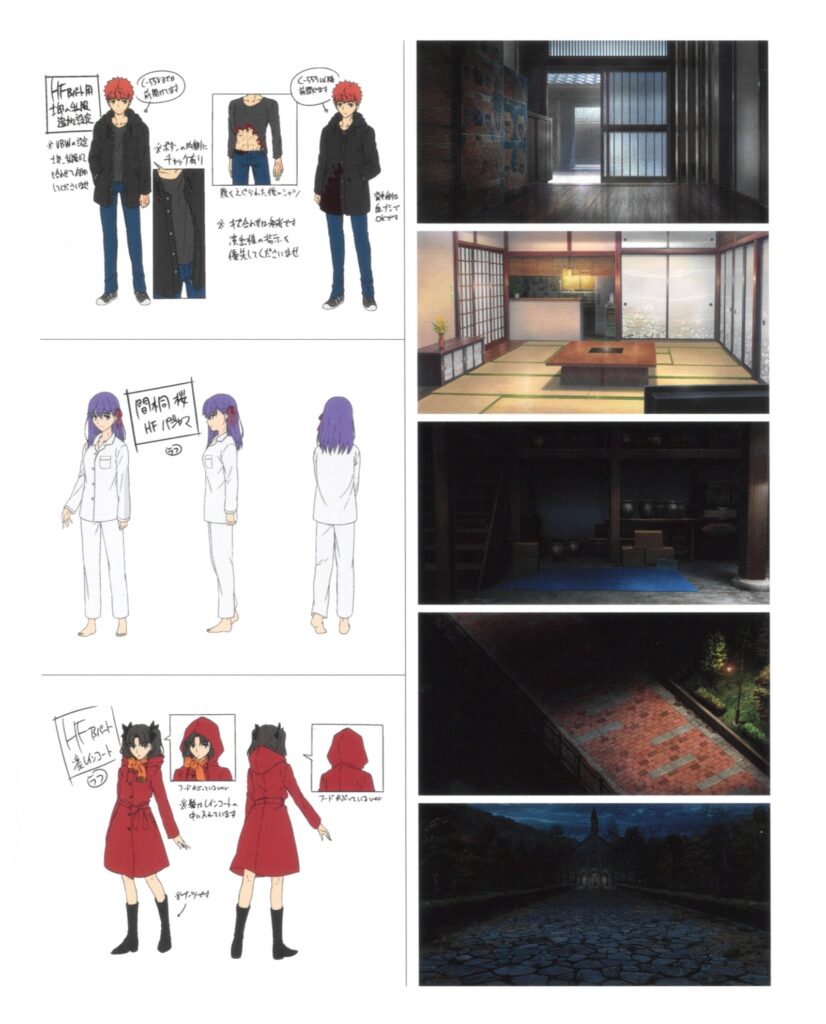
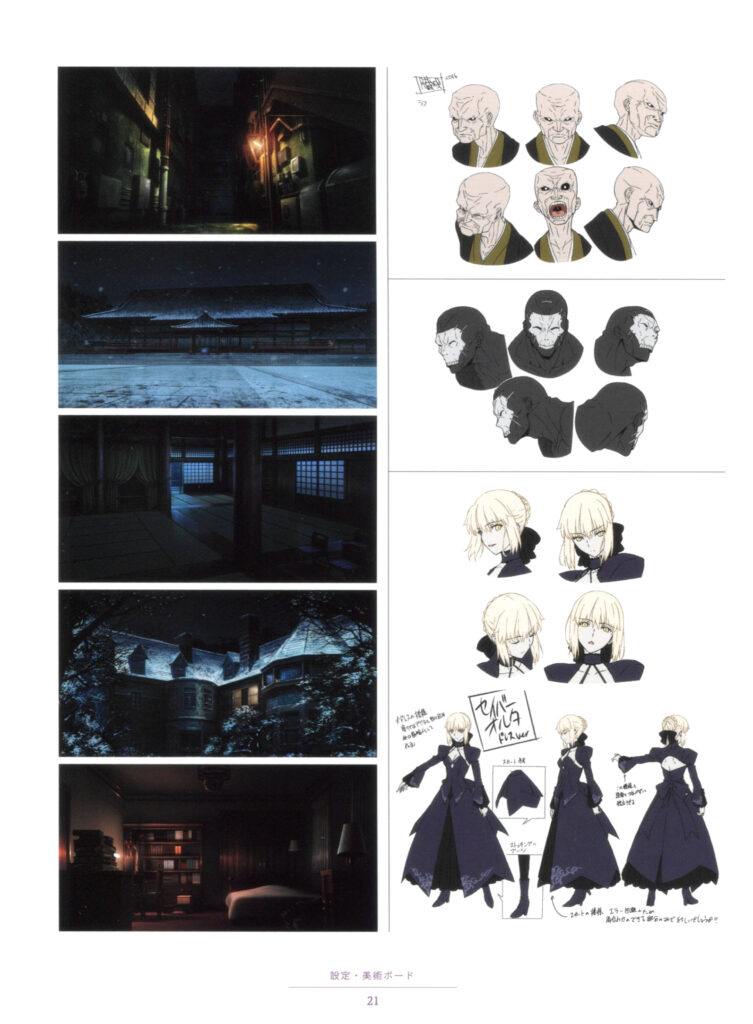
Kinoko & Takashi’s Questions and Answers
Fate/stay night [Heaven’s Feel] the movie I. presage flower version

Q (Factory Ramen): There’s finally an animated version of HF through Sakura’s route. Upon coming up with the character design for Sakura, what was the hardest part?
Kinoko Nasu (hereafter: N): If I were to put it into text, it’d be something like: how do you include an immoral sense of guilt within the heroism and tidiness of an underclassman character? Back when we were making the game version of stay night, we had this mysterious keyword -”neat meat.”
Takashi Takeuchi (hereafter: T): Oh yeah, we did have that. Who said that? We used that phrase like, “We could have made Sakura lean more towards neat meat” or something… And I think we had a character recently where that phrase was like her motif… Ow, my head…
N: To reincarnate into Kiara after over a decade’s time… CCC was a bit too sinful…
Q (Elegant Beautiful Teacher): Sakura was great of course. But Ms. Taiga Fujimura was also amazing, with her mature sexiness. Mr. Nasu and Mr. Takeuchi, did you feel anything about that?
N: I mean, it’s been 10 years since the release, so Fuji-nee would obviously have become an adult… I’m deeply moved.
T: Wait a minute, you talk like a small child grew up to be an adult, but she was already a proper adult 10 years ago.
N: Are you serious? Does that mean I was already an adult 10 years ago too…?
T: Eh… I don’t know about that.
N: Putting that topic aside, Fuji-nee is Fuji-nee, yet still meticulously drawn as an adult female is where I felt love towards her.
Q (Namiyasou): Out of all the extracurricular school activities, why did Shinji choose the Archery club, and how did he get started in Archery?
N: It’s not as popular as the other athletic teams, and it looked like a stoic sport, I guess? I’m sure he would have joined the Fencing Team if there was one.
T: Mm… It’s so complicated.
N: He just couldn’t stay normal. But he was normal. That’s why this story is at an end, Rock…
T: It’s too cruel… I can’t stand to watch…
Q (Silver Moon Mandao): The difficulty of Heroic Spirit summons changes by era, land, and how humanity exists, but is there some sort of prerequisite of “it will never work without this”?
N: You again, Madao? (greetings)
T: How many times has it been, Silver Moon? (greetings)
N: The memories of the land (history), or the memories held by the relic brought in-I don’t think a summons would be possible if either of those were missing. There are cases where the summoner himself is the catalyst, so perhaps it’s just impossible to summon when it’s simply a case of “link/zero.”
T: So Sasaki had some sort of link to the Ryudouji (Ryudou Temple)?
N: He has nothing to do with Ryudouji. He merely trained on the mountain and died on that mountain.
T: So, it was the mountain…
Q (Someone at the far end): The mages call Heroic Spirits “Boundary Recording Bands (Ghost Liners),” but is this the actual terminology? And what does it symbolize?
N: They are not minions created by the Mages themselves, but minions called forth from the history of humanity itself, so they use the term “Ghost Liners” with the nuance that they are “calling forth a phenomenon that was once recorded.” It’s a liner based on the perception that servants are not living creatures but something more like scrolls and documents.
T: Oh, I see. It is true that Heroic Spirits is the common name and doesn’t sound like a Magecraft concept.
N: It’s a term that’s been around from the beginning of the beginning of Fate, even before I wrote the scenarios. But when Lord El-Melloi II’s Case Files was starting up, Mita asked me, “Is there an official term to address Heroic Spirits?” and I presented him with the term. To have it show up in the series world view after 15 years kinda ruins the mood.
T: Says the guy who’s been holding back a ton of settings for 20, even 30 years.
Q (Misunderstanding Boy): What do Sakura’s classmates think about her? Do the boys in her class say stuff like “I’m kind of interested in Matou” or something?
N: Sakura is very gloomy in the classroom, so no matter how pretty and how dangerous a body she has, she is alienated from the boys and slightly avoided by the girls.
T: I… I’m an unfortunate pretty girl…
N: Do stuff like that in Carnival Phantasm. The main storyline is supposed to be super serious.
T: Right.
Q (Ojaki): By the hands of Zouken Matou, the True Assassin was summoned from the Mountain Gate Assassin, but was that a secret trick that was only possible because it was Zouken? Or can other mages suited to become Masters do something similar?
N: It was a secret trick that was possible only because Zouken properly knew the structure of the Holy Grail War. It was like, “What? There’s already an Assassin summoned forth!? Well then, I’ll use the body of that fake Assassin as ‘magical energy to use for summoning’ and summon the true Assassin. The numbers match up, so the Holy Grail will surely malfunction.”
T: The boss character’s rank depends on how many backdoor tricks he has up his sleeve.
N: Because he was the one who created the system, he knows about the backdoor (structural mistakes) that are dangerous if poked at. When boarded up with wook, it gets more and more distorted in shape, and you end up with a blubbery, big, fat Holy Grail War system! However, the Greater Grail itself is perfect in shape, so that remains beautiful forever.
T: Good for you, Grandpa Zouken.
Q (Kyuhey): Mr. Kuzuki vs. True Assassin wasn’t shown, but was Mr. Kuzuki defeated without being able to land a single blow on True Assassin?
N: He might have had some sort of a battle if it was a Servant that faced him head-on, but he was facing an assassin… The logic here is that when it’s an assassin vs. an assassin, the one who strikes first gets the perfect victory.
T: Though I wanted to see an all-out battle between a magecraft buffed Kuzuki by Caster versus True Assassin…
Q (Ramuda): Was Sakura wearing short sleeves in February because the maiden within her wanted to show cute loungewear to Shirou? She was cute.
N: Sakura burning up her inner maiden is worth 10 campfires.
T: Yup, that concept is an upgrade from miniskirts in the middle of winter. Was she not cold? Of course, she was cold!
N: A scary story is… that level of cold, compared to the torture she routinely goes through, is merely “cold” for Sakura. It probably isn’t “hard” for her.
T: SAKURA!!
Q (Kohabu@Egg): There were different presentations in parts between the original story and the movie. The one that surprised me was the battle between True Assassin and Lancer. That battle must have created a large number of casualties and witnesses. How did the priest go about dealing with all of it afterwards?
N: They entered a different city midway, so Kotomine probably pretended he didn’t know.
T: That was the first time we’ve seen expressways and stuff.
N: Probably in Chapter 2 we’ll have some aerial combat, and a helicopter will fall on Goto’s house.
T: And then ufo’s version of Himuro no Tenchi will begin…
Q (Big Flag): Shaitan, the original owner of the cursed arm that is the True Assassin’s Noble Phantasm “Delusional Heartbeat,” is said to be “an evil spirit” or “demon god” or “demonic man” depending on the literature. What category does he fall under?
N: I believe “an evil spirit” would be the most correct nuance. An incarnation of a spirit that was tainted by the human world. However, the incarnation was after his fall, so most of his authority is already gone. It’s rough that I can’t just simply say that he’s the devil.
T: Why can’t you say so?
N: Think about each country’s characteristics.
T: Ooh……
Q (Mangan): After the battle against Lancer, True Assassin looked up at the sky after eating the heart. What happened after that? Did he go pick up his Dark like how it says in the settings?
N: “Heheheh…. Things are very useful nowadays, I can get as many Darks as I want at 99-cent stores…”
T: The problem is that things are too useful. More like, big trouble in Fuyuki’s little 99-cent stores?
N: “Heheheh… though that squiggly thing that came from the bottom of the water is seriously scary… I don’t want to go anywhere near it…”
T: Of course, you wouldn’t.
Q (Starry Sky): How was Zouken Matou controlling the dead Caster?
N: He applied his Crest Worms. He peeled off the vertebrae and squished in a bug that would mimic the spinal cord.
T: That’s some true artisan skills. I wouldn’t recommend amateurs to try.
N: Sometimes, I want to be controlled like that too. I could leave the bug to do my work, and I’ll go gather new materials.
T: What a sad creature… That aside, I’ll give you more work today…
Q (Agnes Takajin): How good of a Mage was Zouken in his prime?
N: Equivalent to Gordolf (an average third-tier noble Mage) x10.
T: Make it easier to understand and be more specific.
N: If we were to say his prime was “before joining up with the Einzberns,” he would fare well even against a servant, and can even win (probably against one Servant) under good conditions. He’s a pride around level 70.
T: How many Kariya’s from Zero would it take?
N: Hohoho. No matter how many zeroes you get, it’s still zero.
Q (Deucalion): How did Archer have a clue about what the “Shadow” was? Did he encounter something like it in life, or did he stamp out something like it during his duties as a guardian? I’d love it if you could answer.
N: I don’t think he encountered it while living. When you’re a guardian for a long time, you end up encountering things where “its existence itself is antagonistic to humans.”
T: The design orders for the octopus was something like: “an alien existence that would be recognizable at first sight; a materialization of a nightmare,” and it had been a while since I got shivers up my spine when I saw the footage.
N: I just love stuff like that! Japanese horror that silently appears in the corner of everyday life is the best!
T: The costumes that will appear in the second half is used as a motif by all sorts of characters but the pure octopus form was an unexpected reunion after 10 years, and I almost had a new story between me and octopus.
Q (Gyro): How often does Kotomine eat out at Taishan (Chinese Restaurant)?
N: When he feels like it. He usually tries to eat frugally at the Church.
T: When does he feel like it?
N: You know how humans have strange premonitions at times? Like that spark of intuition where you think, “Oh I think I can pull a good one with a summon ticket right now.” Stuff like that. So Kotomine himself can’t control it, either.
T: So, it’s not like he eats at the restaurant every day, then.
Q (S from Romania): According to True Assassin, Servants cannot oppose the shadow, and pure Saber will lose her sanity merely by touching it. Does this “purity” refer to how she is a hero and not an anti-hero?
N: Correct. A straightforward Heroic Spirit has no tolerance against curses, so the Spirit Origin will be corrupted along with extreme pain. For an anti-hero, who is “closer by source,” there will be some corruption but no extreme pain, giving them a slight mental margin to think, “Oh, this isn’t good, this really sucks.”
T: So, to the certain darkest of darkness, it would be like soaking in the hot springs?
N: Right. But his anti-magical energy and stuff are at the lowest rank, so it’s like “it doesn’t hurt, but will get swallowed up instantly.” Though in his case, he would still take joy in things even after getting swallowed up, saying stuff like, “By the way, is there a manga cafe around here?”
T: I sense a spin-off in the works! Lethargic cynical everyday life manga, The darkest dark’s Holy Grail Living in the Cheap Lifestyle!
Q (Helt): When Rin went into the insect hold, she was at a loss of words at its terrible sight. Just how much about Sakura and the current standings of the Matou household did Rin know at that time?
N: Mages conceal their own teachings and spells, so she could only imagine what kind of teachings Sakura was receiving. Matou has their own way of teachings, and to try to find out what they would be equal to a deathmatch.
T: If she knew, she wouldn’t have let them be, either.
N: It’s such a sad tale when the hero you had so much faith in sending off ended up becoming a slave for a company that exploits employees…
T: In the end, they get promoted amazingly well, though…
Q (Black Pawn): In the Fifth Holy Grail War that Archer was retracing, were the inner dealings of the Matou clan or Sakura’s circumstances known? If he had known, how did Sakura look through Archer’s eyes in this particular Holy Grail War?
N: That Archer only has “memories of Saber” when it concerns the Holy Grail War. When he was summoned, seeing his summoned before him, he started to acknowledge things around Rin as “his own things.” The inner dealings of the Matou clan is something he didn’t know before turning into a Servant, and Sakura’s current circumstances were something he deduced after being summoned for the Holy Grail War. But that doesn’t necessarily mean that he would assist Sakura. Archer is Archer. It’s not the guy.
T: He remembers just Saber… you’re talking about the opening scene in the original game.
N: It’s not that he clearly remembers details. His memories are vague, and at the point where he was assigned as a guardian, his memories are all blended together chaotically regardless of past or future. So, he no longer has the sensation of “what he feels is beautiful” anymore. Just think the “first contact with Saber” was something engraved into his soul as an art graph. Also, how that young man met Saber and how he was involved is something completely different from that in stay night.
Q (Smile): After seeing HF for the first time, what kind of conversations and comments were made among TYPE-MOON staff?
N: Amazing! Just amazing!
T: Amazing! Just amazing! …were words that did not readily come out because they were probably completely floored. It had a strong enough impact that you could say we were all intoxicated.
N: It was the late-night premiere showing at Machi*Asobi, but we were all so excited afterwards that we couldn’t sleep. Meanwhile, Ms. Kawasumi was a part of the premiere showing the next day, and she left a heartwarming tale that she saw the movie even in her dreams.
T: Yeah. If that showed up in your dreams, it’s definitely a nightmare.
Commentary Book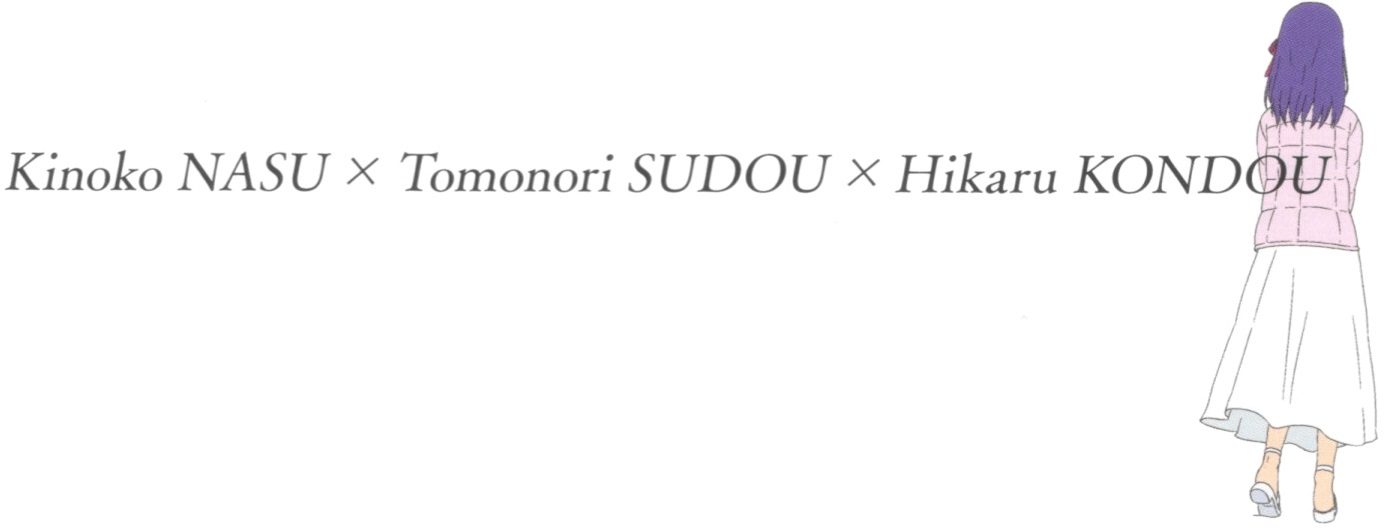
Fate/stay night [Heaven’s Feel] the movie I. presage flower commentary book
Chapter 1 was filled with soul, three years in the making after the movie announcement
Commentary Talk 01: The long night at the industry screening
Q: Today, we have Kinoko Nasu, Director Tomonori Sudo, and Producer Hikaru Kondo here with us to do a movie commentary chat session. What were your thoughts after watching Fate/stay night [Heaven’s Feel] the movie I. presage flower (hereafter: [HF])?
Nasu: I had the chance to visit Machi*Asobi vol. 19 in Tokushima, and I got to watch the final version of [HF] for the first time at the industry screening held in ufotable CINEMA. After the screening, the first thing I did was to pull Sudo by the arm to kidnap him to pour my heart out to him. I made embarrassing comments like any average fan. (laughs)
Kondo: I watched Nasu drag Sudo off somewhere. (laughs) It was obvious at first glance that Nasu looked really happy, so I was thinking, “Good for you, (Sudo)” while I felt some relief myself.
Nasu: Until I saw the Final version, I wasn’t sure if this piece would end up as a “problematic title” or a “movie that was highly polished.” However, I was confident from the time I attended the voice recordings that it will satisfy the expectations of the fans of the original game. But when I saw the final version, I felt that [HF] was a film that both the original game fans and the movie fans would enjoy, like it was some sort of miraculous film. I felt so fulfilled to see something as magnificent. So I couldn’t help but to pour my heart out to Sudo.
Sudo: The reactions you get right after a viewer finishes watching are the scariest. The feelings you harbor right after you watch it for the first time stays with the viewer the longest. So I was very happy to see that I was able to leave something (within Nasu) from that first viewing.
Commentary Talk 02: The decision to draw from a year and a half before the “Holy Grail War”
Q: How did the beginning of [HF] Chapter 1 where the story begins a year and a half before the “Holy Grail War” come about?
Nasu: Sudo’s initial presentation was one where he asserted, “I want to start drawing a year and a half before the Holy Grail War.” He told me that he wanted to properly draw out the relationship between Shirou and Sakura. He said “That’s why I want to start drawing at the point where Sakura first arrives at Shirou’s house.” Then, he showed me the storyboards for the prologue. I replied, “Wait you’re going to draw this part out? This is a fantastic storyboard. Go ahead with it.” I also told him “[HF] is a story about Shirou and Sakura, so I’ll leave organizing the story up to you, Sudo.”
Commentary Talk 03: Shirou Emiya’s past and the Shahou-Hassetsu

First half depicts Sakura’s humble happiness
Q: Let’s talk about specific scenes. We started with a scene where Shirou was practicing Japanese archery.
Sudo: Someone on our animation staff used to be in the school archery team, so we were able to ask for concrete details. We also learned the detailed movements since someone brought a book about Japanese archery for beginners. We also watched various films to use as a reference.
Nasu: A lot of users probably have forgotten that Shirou’s Projection is an adaptation of the Shahou-Hassetsu in Japanese Archery.
Sudo: Shiro isn’t thinking about “hitting the target” when he shoots the arrow (the “hanare/release” of the Hassetsu). That’s why his expression doesn’t change, and he doesn’t move from his neck up, resulting in only his body moving. Trembles in his body all cease at the moment he shoots. Those were things I was careful about when drawing.
Q: Afterwards, Shirou injures his shoulder during his part-time job. When Shirou says, “I’m home.” to an empty house left a lasting impression.
Sudo: Normally, Shirou doesn’t feel pain about his solitude. However, Shirou calling out to an empty location like this is viewed by the audience as “unfortunate.” How will this perception change when this [HF] story ends? I felt that nurturing the feelings audiences feel toward Shirou was one of the themes for this piece.
Commentary Talk 04: Sakura Matou’s visit on a rainy day
Q: And a rain-soaked Sakura visits shirou. On the surface, she’s here to “take care of Shirou,” but she also has a hidden agenda.
Nasu: The Matou side has a separate, true objective. Sakura herself knows that she is doing something out of the ordinary and realizes that she is troubling the good-natured Shirou. But she has to do it because she was ordered to. However, after a year and a half, her relationship with Shirou turned into something irreplaceable.
Sudo: That’s why when Shirou’s shoulder injury was fully healed, it troubles Sakura to be told “That’s it.” Those feelings must have been within her.
Nasu: Well, that’s how she ends up managing to get the key to the Emiya household. (laughs)
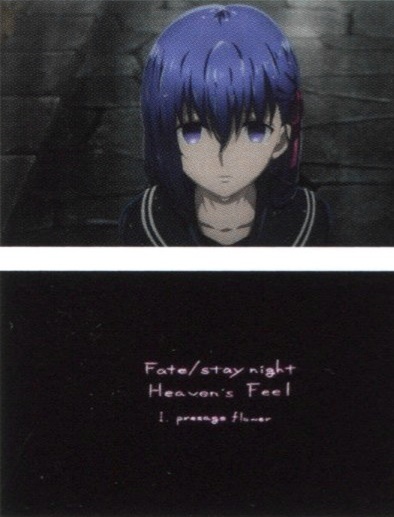
Commentary Talk 05: Feelings for the handwritten title
Q: After Shirou meets Sakura, the handwritten title for Fate/stay night [Heaven’s Feel] I. presage flower shows on screen. How did that come about?
Sudo: I wanted the title to be something “really casual.” Originally, I had the title screen in normal font, but when Yuki Kaijura (music) finished up her touch sounds (ME/music effects) I felt that the font was a little too stiff. Kaijura had presented the image of “the beginning of a soft, everyday life,” so I wanted softer, handwritten letters here.
Kondo: That handwritten text are Sudo’s actual handwriting. I planned on going without music for the initial scene, but I asked Kaijura for some touch sounds. I’ve been working this job for a long time, so I knew that something like that might be needed in the future. I also considered the film not having any touch sounds, but by having sound here, the timeframe before and after the title screen tied together much better. Kaijura gently inserting a melody in there was also effective.
Nasu: That handwritten title screen had the imagery as, say, “going into some building ruin, and in a room that someone probably used to live in, a girl’s diary was found.” Words written on a girl’s diary… it gave an air that someone’s personal tale was about to begin.
Commentary Talk 06: Sakura Matou’s maturity and change
Q: Afterwards, we have quiet scenes where Sakura can be seen maturing bit by bit.
Sudo: I felt that it was most important for the audience to like Sakura from the opening scenes. At the beginning of the original game, Sakura is depicted as “an underclassman who comes over to help out,” so you see a side of her that is bright and homely. But with this film adaptation, we had to share with the audience “Sakura’s maturity and changes that only Shirou knows about” or they wouldn’t be able to sympathize with Shirou’s doubts and inner turmoil later on. The audience wouldn’t be satisfied if we drew out the drama to come afterwards if they don’t know Sakura all that well. That’s why I wanted to properly show Sakura’s closed off heart slowly changing. When you see someone maturing, you have an attachment to them, right? Not just because she’s a cute little girl, but you feel protective like a parent, or even maternal instinct saying, “You tried so hard!” I thought it would be great if I could draw out such emotions.
Nasu: It’s true that in the original game, Sakura is drawn out as “the underclassman that comes to help out” and the players felt like that “was a typical setting for any game.” In the Saber route ([Fate]) and Rin route ([Unlimited Blade Works], hereafter [UBW]) we teased the notion that Sakura had some kind of reason to be coming over to Shirou’s house… and finally in the Sakura route ([Heaven’s Feel]) we finally gave an explanation. So the players now know, “So that’s why Sakura was coming over to Shirou’s house.” We had those steps in place, and that’s why Sakura works as the heroine. That’s why she became someone worthy of loving. I felt that where the game took major detours, this [HF] film used the opening 20 minutes to draw it out in a careful manner.
Q: And as a year and a half goes by, Sakura’s happiness comes at a peak. She even says lines like, “I can no longer eat a tasty meal unless I’m at your place.”
Sudo: Sakura says that line with a smile, but when you think about its hidden meaning…
Nasu: It’s rough.
Sudo: …It’s rough indeed. And, Shirou doesn’t realize it at all. When we were drawing the scene, we were careful to not show that hidden side of Sakura. We (the production side) understand the complex emotions Sakura harbors, but it’s no good if we try to draw everything. We drew the scene while completely shutting out that hidden side.

Commentary Talk 07: Shinji Matou and Taiga Fujimura
Q: The emotions of Sakura’s older brother, Shinji Matou, is carefully depicted as well.
Sudo: Shinji is a character that remains unchanged in all the routes. However, how you look at him changes by how the camera looks at him, and what kind of pauses you insert for him.
Nasu: In the screenplay, I fixed Shinji’s lines the most. They’re short lines, but I wanted them to be vague enough for some misinterpretations. But I also didn’t want any mistaken misunderstandings. Shinji has a terrible personality, but he’s not a clump of evil. He could have been a good friend had it been in other situations.
Q: We believe Taiga also was depicted in detail this time.
Sudo: When Kiritsugu was alive, the relationship was that Kiritsugu was the guardian, Taiga was the eldest daughter, and Shirou was the youngest child. But with Kiritsugu gone, and you add Sakura to the picture, Taiga becomes the guardian, Shirou the eldest son, and Sakura the younger daughter. Shirou has never taken care of younger kids before, so he has all sorts of things he wants to ask Taiga who is also a teacher. I was always conscientious of the continuous connection as a family throughout production for this piece. For Taiga, Shirou learning to become an older role model for Sakura was probably a happy welcome. That’s why I believe Taiga looks on in a heartwarming manner as Shirou teaches Sakura all sorts of things.
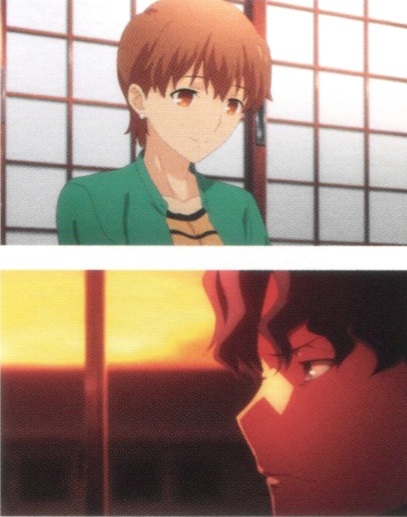
Commentary Talk 08: Encounter with Illyasviel
Q: The day before, Illyasviel (hereafter Illya) encounters Shirou. Then Illya forces herself into Shirou’s dream later that night. Can you tell us a little bit about this turn of events?
Sudo: Normally, Illya would tell him: “If you don’t summon yours soon, you’re gonna die, mister,” right there on the street where they first meet…
Nasu: But, this is not a natural scene. If you’re out on the street and some unfamiliar foreign girl suddenly tells you, “If you don’t summon yours soon, you’re gonna die, mister.” This scene only works because it’s a typical scene in a game. When you try to do that in film, the unnaturalness of that scene is exponentially greater. After pondering, “Who was that foreign girl on the street?” and then having that same girl showing up in a nightmare the same night… that that turn of events is a wonderful flow film-wise.
Sudo: The fact that Illya infiltrated Shirou’s dream also proves the difference in power (as a Mage) between Shirou and Illya. Also, the fact that Illya tugs on him from behind while Shirou is having a dream of Kiritsugu (Emiya, his adoptive father) is also a materialization of Illya’s feelings – “How dare you be the only one having dreams about Kiritsugu!”

Commentary Talk 09: The curtain rises on the “Holy Grail War” and presage flower blooms
Q: Finally, it’s the start of the “Holy Grail War.” It’s the day where Shirou gets roped into a Servant battle after school. The inserted scene where Sakura was reading a book had a lasting impression.
Sudo: Looking at Sakura’s profile for Fate/stay night, Sakura’s favorite things are “ghost stories.” That changed into “scary stories” in Fate/Zero. I’ve always wanted to ask Nasu the reasoning behind that…
Nasu: For Sakura, reality is a “scary thing.” Since she has grown a tolerance for “scary things,” fictional “scary things” is something familiar to her. Back then, I had written Sakura out as a girl who read “ghost stories” to keep her mental balance together because reality was so harsh on her… and she was also subconsciously interested in the mechanisms that made people feel scared.
Sudo: At this time, Sakura was reading Lafcadio Heam’s Ubazakura from his book of Kwaidan. As I wanted to have the actual text on screen, I decided to choose something from the public domain. Hearn’s Kwaidan has two stories with cherry blossoms as the theme – Jiu-Roku-Zakura and Ubazakura. Jiu-Roku-Zakura is about an elderly samurai who commits seppuku under a withered cherry tree. At the end of the story, because he sacrificed his own life, the cherry tree blossoms beautifully, in Ubazakura, a couple who have not been blessed for a child finally gains a beautiful daughter. She grows up being loved by her nanny, but the daughter ends up falling ill with a grave illness. The nanny risks her life to pray, and dies in exchange for the daughter’s survival. The last request of the nanny was to plant a cherry tree… I’m sure that Sakura doesn’t understand the meaning behind Ubazakura even when she reads it. Why is the daughter loved so much? Why does the nanny go so far for this daughter? That’s precisely why she reads the story over and over. Sakura in [HF] Chapter 1 still doesn’t understand what it means to be loved.
Nasu: It really makes me happy that Sudo fortifies the story of [Heaven’s Feel] like that. Details like this makes it an effective animation.
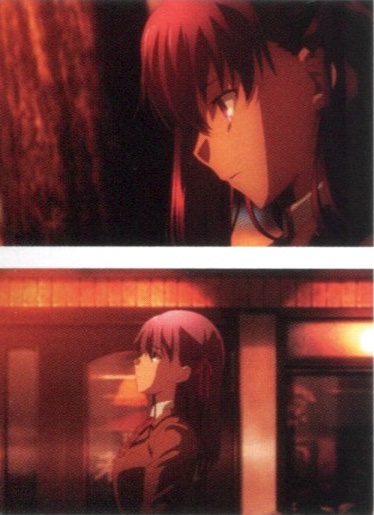
Commentary Talk 10: First Battle – the Einzbern Master
Q: The “Holy Grail War” finally commences. The first battle is against Berserker.
Sudo: I wanted the story to flow straight from Fuyuki Church to the Berserker battle. I didn’t want the flow of the story to be where the characters talk to Kotomine at church and encounter Illya walking the streets and night afterwards. So we had the events unfold such that Illya was already on the move while Shirou was talking at the church. Which meant that Saber, who was waiting at the church gate would be the first to encounter Illya. I then thought, “what would Illya talk to Saber about?” Illya knows about the rule where “Servants’ memories are reset after they disappear,” but she doesn’t know how Saber became a Heroic Spirit. So she asks “about the Einzberns,” for the time being. Of course, she has no expectations of getting an answer. Art-wise, we tried to not have Saber show any emotions as well.
Nasu: It was great to see Illya spinning around during the Berserker fight. Why was she spinning around so much?
Sudo: Illya may look young on the outside, but I wanted to make her seem very mature inside. She is spinning around during the Berserker fight, but I thought I should make it slightly sexy. I asked the key animators to “not draw an energetic child frolicking, but draw an intoxicated woman overcome with emotions.” In the storyboards, I put the note, “like an opera singer.” I wanted to show that Illya was more mature mentally than Sakura through [HF]. Depictions of Illya become important in Chapter 2 and on, so the line “you can violate her after beheading her” was in accordance with the PC version of Fate/stay night to express Illya’s sex appeal.
The middle part, where Servant battles beyond human understanding are drawn

Commentary Talk 11: Second Battle – Saber’s strength drawn in the Rider battle
Q: The Rider battle was glorious, including the music
Kondo: This is the only scene where Saber gets real action. Sound-wise we needed to strengthen the chain sounds (SE/sound effects), or rather, I would have loved to do so, but I held back on the SEs and let Kaijura’s music (soundtrack) be more emphasized. Actually, I had her hold back quite a bit on the soundtrack up to this point. The prologue had less music, and the Berserker battle had loud sound effects. This is where I wanted the viewers to feel good by echoing the soundtrack within the film itself.
Sudo: It’s a scene where the protagonist side gets a proper victory, too.
Kondo: You can probably tell if you watch again, but for the Lancer-True Assassin battle that follows, I have really loud SEs, but in the Rider battle I dropped the volume levels of the SEs.
Sudo: The scene where you’re trying to convey the heroism.
Kondo: I put depth with the sound, so you could have a sense of space acoustically.
Sudo: Back when I was drawing the storyboards, I knew I didn’t have much screen time here, so I put thought into what kind of a situation would be good for them to fight under. In the original game, they fought in an open area of a park, but considering Rider’s characteristics, it was easier to fight in a three-dimensional setting, so I took the liberty of changing the battlefield to a back alley.
Nasu: When we first had a meeting about the screenplay, I mentioned, “You don’t need to fight at the park (just like in the original game), so you can choose a different situation.” The original game had limitations on the number of 2D backgrounds we could use, so in battles, we only had the park or a hilly road. (laughs) But in animation, there was no need to conform to those limitations. The anime staff all held high regards for the original game, so they got picky about situations that are depicted in the original game. But I was afraid that “the decisions reluctantly made on the original game due to production limitations might be inherited to the animated version.” But considering our history together of all the titles we’ve worked on, I had the confidence that ufotable had the manpower and the reliability that they would do something about it. So I told them, “It’s fine if it’s not perfectly conformed to the original story.” By saying so, the staff had the joy of presenting the best possible suggestions without fear.
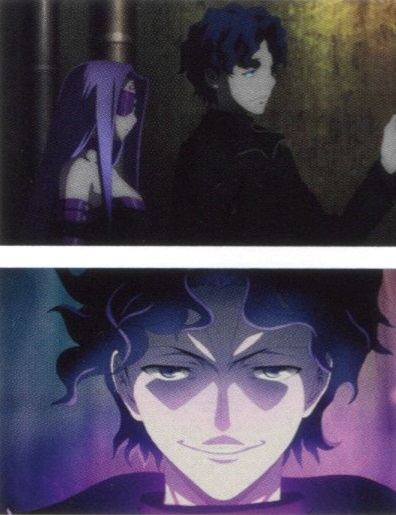
Q: After this Rider battle, Zouken finally appears himself as the enemy.
Sudo: When we designed the back alley in 3DCG, I specified a location where light should never shine upon, I made it so that Zouken would appear out of that shadow where light never shines. I wanted Shinji to cower looking into nothing and give the premonition of Zouken’s appearance with just Shinji’s acting. And then, Zouken suddenly appears in the back alley, and it flows into Matou’s declaration of defeat. I also instructed that when Shinji clings onto Zouken, Shinji’s head must never be above Zouken’s.
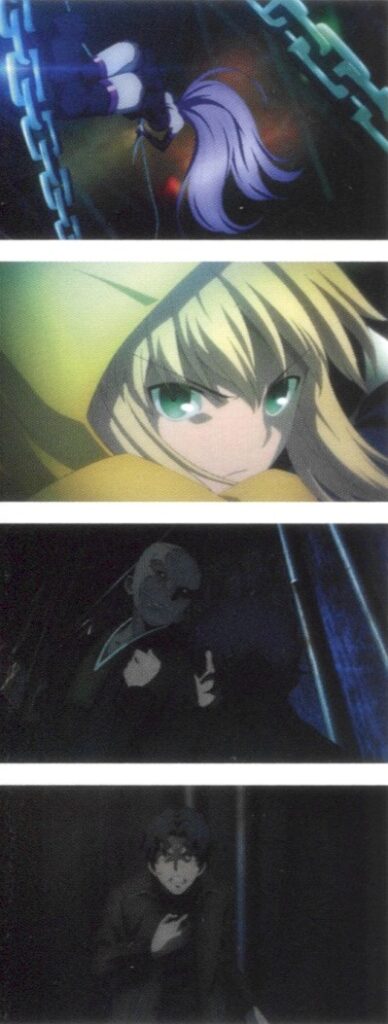
Commentary Talk 12: Distortion of the “Holy Grail War,” the emergence of True Assassin
Q: True Assassin is summoned from Assassin, True Assassin then assaults Souichirou Kuzuki and Caster upon appearance. What do you think about this scene?
Sudo: Timeline-wise, when this incident is going on, Shirou is at the side of Sakura’s bed, nursing her. I wanted to convey that the situation was moving forward while Shirou was not involved with it at all. At the same time, I wanted True Assassin to have a sense of existence as a mid-boss working under Zouken. At this point in time, True Assassin’s intelligence is lowered (due to a special summoning), but I felt that I should show how clever he is just from his instincts as an assassin. That’s why he goes for the throat first when he’s up against a Mage (Master). When killing Kuzuki, True Assassin says “First, I cut his head,” but that’s probably because he thought Kuzuki was a mage. I thought it would be good to draw that part out well. I personally like how True Assassin tilts his head right there.
Nasu: The animalistic movements of True Assassin are great. And yet, his instinctive actions (assassination) are done with minimal movements.
Q: This is when Caster uses the Noble Phantasm. Can you tell us about this turn of events?
Sudo: It was partially meant as an introduction to prepare for Chapter 2 and beyond, since I thought I had to show Caster’s Noble Phantasm right here. I made it so that the audience can see that the effects of this Noble Phantasm is not to deliver damage, but to sever pacts.

Commentary Talk 13: Shirou Emiya’s anger, Shinji Matou’s ecstasy
Q: Then, Shinji shows up at the Emiya residence, and Shirou has a conflict against Shinji concerning Sakura. This is the scene where Shinji is happy that Shirou has shown some emotions.
Sudo: Right. In this piece, the three (Shirou, Shinji, Sakura) don’t have any other scenes where they are together…
Nasu: True. This is the only spot.
Sudo: In this [HF] Chapter 1, I basically couldn’t make any scenes where Shinji and Sakura are together. A scene where the siblings are together, and Shirou is also there; it’s a very valuable scene. That’s why I wanted to show an explosion of emotion right there. This was also the scene in the original game where Shirou first “harbors an intent to kill Shinji,” so how does Shinji react to this? How does Sakura stop Shirou? In the storehouse scene that follows, Shirou still can’t contain his feelings. And then Sakura shows up, and I kept in mind the emotional ties between those two scenes.
Nasu: To begin with, considering how Shirou has lived until then, he wouldn’t be able to butt into the relationship between siblings. He’s not programmed to be able to act upon it. Shirou has circumstantial evidence that Sakura is being abused by Shinji, but this was the first time he witnesses it. Sakura has become so dear to him that he couldn’t help but to lash out at Shinji with his opinion. That’s just how much he couldn’t tolerate Shinji’s actions. He probably had some frustration against himself that he couldn’t save Sakura, too.

Commentary Talk 14: Shirou Emiya and Sakura Matou left behind
Q: Nasu, how did you interpret the storehouse scene that followed?
Nasu: The lonely yet warm scene was marvelous. It was the most important scene, and the lighting was beautiful as well.
Sudo: In the original game, they talk about all sorts of things, like how the siblings were. But in this piece, I inserted the story that was most important for Sakura – how she was “watching Shirou high-jumping in the courtyard back in middle school.” In the original game, Sakura talks about this in the common route (the first three days), but I wanted the prologue segment to have a good tempo, and I wanted Sakura to talk about it when the audience could concentrate most on what Sakura had to talk about. Direction-wise, I wanted the light to be as small as possible and I wanted a sense that they were alone, surrounded by the size and darkness of the storehouse. That’s why I pulled the camera pretty far back and drew it so that the two of them are isolated on the big screen. As a result, I ended up with a valuable scene where it looks like the two of them are sharing one light. On top of that, the single light is artificially created by a stove, and it is destined to disappear in due time.
Nasu: Which means the relationship between the two won’t last long…
Kondo: The key animation for this scene was done entirely by (Teiichi) Takiguchi who directed the Garden of sinners: garan-no-dou (The Hollow Shrine), and it ended up to be even more of a stand-out scene.
Commentary Talk 15: Servant chase Lancer vs. True Assassin
Q: How did you think the feature action scene, Lancer vs True Assassin Servant chase turned out?
Nasu: I had known about it from the storyboards, and even I thought, “What the heck is this!? Amazing!” So it must have left a big impact on (Takashi) Takeuchi (original character designs) who was watching next to me at the screening. I’m guessing ufotable, as they have been involved in the Fate series thus far, came up with amazing concepts on just how far to take a Servant battle to make it look good. It was so amazing that I can’t think of any Servant battle in the past that was as balanced as this one. Servants may be Heroic Spirits, but they look human – and yet, they’re amazing when they’re mobile. In a time where Servants appearances are getting inflated within the Fate series, I felt like I saw a prim-and-proper Servant battle.

Kondo: Also, if you look closely at the battle scene, there are lots of people walking around on the other side of the building. The expressway has people driving normal cars, too. I think we finally were able to convey some reality in there that a Servant battle is taking place in an ordinary town called Fuyuki, and the realism that (a battle might actually be taking place near me). For Fate/Zero we had to choose places with few people around, like a wharf, for the battleground. But this time, we could properly let them take place on expressways where cars are being driven, or urban areas where people are around. For all that’s said and done, I think it was a good thing we did this.
Nasu: One of the interesting aspects of [HF] is how the Servants who were so powerful in the [Fate] and [UBW] routes just collapse one after another. The previous routes basically act as the introduction to a mystery. But since there would be people where [HF] is their first look, I had my doubts on whether or not [HF] alone would be enough to express that “Servants are powerful” as well as the “terror of the possibility of dying easily.” But this battle expressed enough of the strengths of the Servants, so you can see just how ominous the “shadow” that defeats such Servants is. This battle between Lancer and True Assassin looks like a service shot for the audience, but it’s actually a highly important scene.
Commentary Talk 16: The notion of discomfort of the 2-D “shadow”
Q: And the “shadow” will finally manifest
Sudo: The “shadow” was really difficult, as I had heard from Nasu that “(the shadow is) a two dimensional existence.” You just don’t feel that much discomfort when you place a two-dimensional object within anime, which is a film medium expressed via drawing. I thought quite extensively on what to do so that we end up with “a character whose existence differs from others” within the footage. The “shadow” is drawn by 3DCG, but if we specify the light source, there would be parts where the character has parts that are brightly lit, and parts that are in shadows. However, this “shadow” that we have here is an existence that absorbs all light that shines on it. So, I asked the filming staff to “cut all lights, no matter where it shows up.” Whether that be a snowy scene or a rainy scene, no light whatsoever. The processing that the filming staff usually adds… such as reflected glare, or reflected light, or your own shadow, or how water bounces off objects when it’s raining–we removed everything of that sort, and had much trial and error in order to increase the “discomfort.”
Nasu: The “shadow” symbolizes “something that doesn’t originally belong in this world.” For instance, when you come home and think how tired you are, but then you think, “Wait, is there something right behind me?” I wanted terror of that nature. I think how we drew it in this piece is the optimal solution. Where it’s walking around the park, it looks so lonely, and when it’s watching a group of people from afar because it can’t join in the circle makes it even more pitiful. And that’s just when it happens to see Rin and instinctively attack.
Sudo: I tried to pull the camera back as much as possible in the scene where the “shadow” appears so it feels like there is a sense of distance. Of course, the camera zooms in during the action portions, but I felt it was important to keep a distance. Though, Shirou is just a bit crazy as he tried to march right up to it. (laughs)
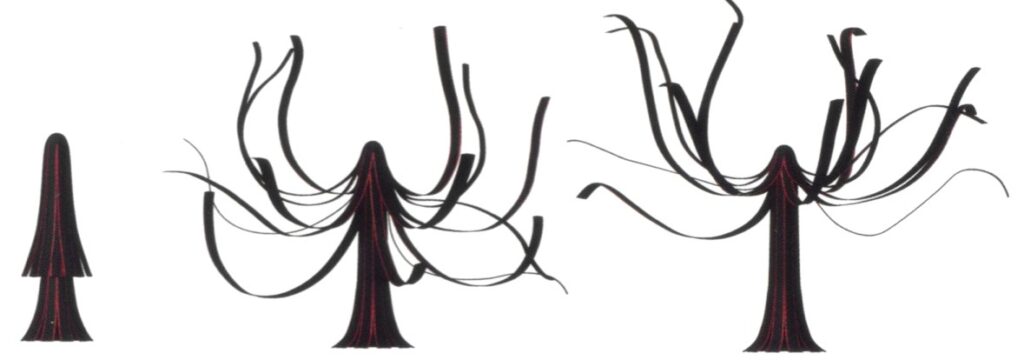
Q: The footage right when Shirou contacts the shadow was unique.
Sudo: I was influenced by the imagery from Nasu’s original game text. That part, unlike all other texts, was one phrase of an image after another. So I thought it best to not make a footage that the audience can digest. I actually gave Nasu’s text to the individual who was in charge of the scene.
Nasu: …!?
Kondo: How many frames was it?
Sudo: I think some that were only one frame long.
Kondo: That means there were lots of images that the human eye couldn’t catch.
Sudo: Right. Overlapped some images that moved in 3D, but the images switched over immediately, so there should be a few that cannot be discerned.
Kondo: One thing you know is that it “makes you feel sick.”
Sudo: I also asked the sound folks for the sound that is used there…
Kondo: Right. I made the sound there to circle around the entire theater. That scene was the one that had the most sound rotation within [HF].
Sudo: It only lasts three seconds, but we shook the audiences brains for three seconds before returning to a scene from reality.
Commentary Talk 17: The scene at the Chinese restaurant Hongzhou Feast Hall: Taishan
Q: The appearance of Mr. Ba, the owner of Taishan, was a pleasant surprise to fans of the original game.
Nasu: Mr. Ba is a character whom I had internal fantasies where “(Kirei) Kotomine and Ba used to team up in the past,” so I was like, “finally this character makes an appearance.” As Kotomine was suspected of “not having blood running in his veins” in the original game, this scene was there to tell the players that he is human that actually has a life. Until this point, Kotomine was depicted as a character who has a distinct set of values different than ordinary people, so there were no images of him eating meals or living an ordinary life. I had been deleting such images of him on purpose. After imprinting on everyone that Kotomine was a character as such (evil), I wanted players to feel in the last chapter that “Kotomine is a human so he does eat meals. He is a human just like you.” In that aspect, Taishan is an important scene where players felt a slight familiarity (towards Kotomine) and that Shirou’s guard against Kotomine is slightly lowered. I was happy to see that it was drawn out in such a solid manner.
Commentary Talk 18: The climactic battle at Ryudouji
Q: Here, we have Shirou vs. Zouken fight and the Saber vs. True Assassin fight happening simultaneously.
Sudo: Rendering the snow was difficult at Ryudouji. It just keeps snowing throughout the battle, so we had our staff delete one part of snow that was falling at the front edge of the screen, and that would be a retake in itself. It really was strenuous. We had done a scene where snow continuously falls within the Garden of sinners the Final Chapter movie, but…
Shirou and Sakura left all alone within the fierce helix of battle
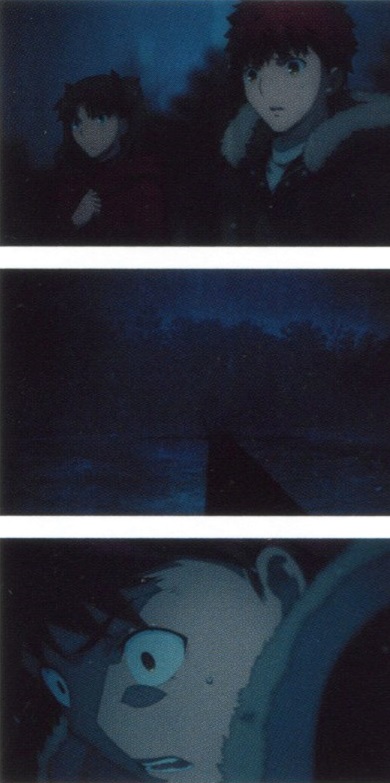
Kondo: That was a movie where we tried a lot of experimental methods. We kept trying mundane things over and over, such as when it snows, it piles on top of already fallen snow. Outside of that, it became a great fountain for ufotable titles to follow, such as the production system we used. For this particular piece, the footprints left by Saber on the snow were beautiful.
Sudo: Saber’s footprints were drawn by the art staff. Until then, footprints on the snow were drawn on cels (as key animation) and we only had them draw the shadows (created by the bumps on the footprint), but this time around, we had the art staff draw them.
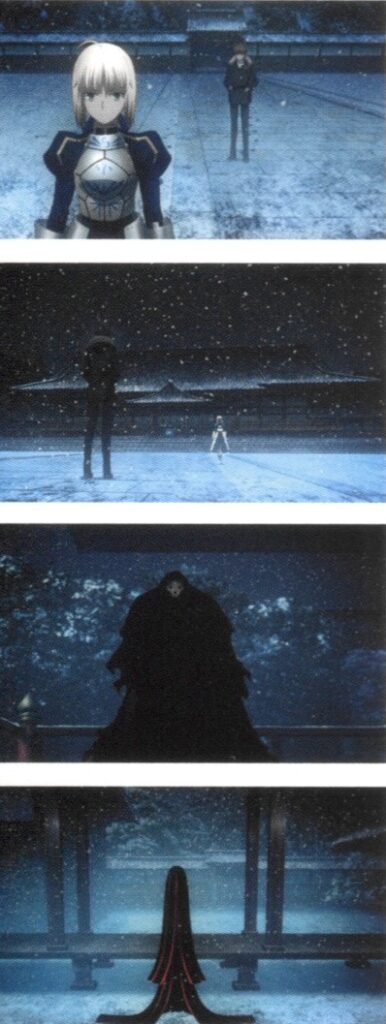
Nasu: The film has the same outline as the original game, but each leave a different impression. I think the pinnacle of the difference is in this scene. Just like the original game, it’s Ryudouji at night, but it turns into something else just by adding snow into the environment. This scene was only a cushion before the next big plot development in the original game, but I think it turned into a spectacular scene fit for gracing the finale of [HF] Chapter 1. Who would have thought to make it snow here! Also, when the “shadow” appeared from the surface of the lake, it was so powerful that I wondered if this was a monster film!

Q: Rider’s reappearance is another highlight here.
Sudo: I wanted characteristic movements for each Servant. For Rider, I requested that I want her hair to wind back and forth like snakes. Miura interpreted that perfectly in the storyboards, so while True Assassin moved in straight lines, Rider chased him using curves… that was really awesome.
Kondo: Miura’s storyboards were unique. When he’s on a roll, the letters on the storyboards get bigger. (laughs)
Nasu: It’s been a little more than a decade since Fate/stay night first became animated, and Rider as the main spotlight finally got animated. I am so delighted!
Kondo: Expressing Rider’s chains was really cumbersome. The chains in that scene include 3DCG, but a lot of them were hand-drawn, so that scene was made possible by the technique and patience from the staff. Also, there is one cut at the end of this scene that was really risky.
Sudo: Oh, you mean that cut where the shadow comes out.
Kondo: We took the plunge to cut all sounds out. I silenced everything, including sound effects and soundtrack.
Nasu: That scene was really fascinating and grabbed the attention of everything—including your consciousness. I think that was the best shot ever.
Commentary Talk 19: Last scene Shirou and Sakura reuniting in the snow
Q: When Shirou, no longer a Master, arrives at the Emiya residence, Sakura is waiting for his return in the snow. Can you tell us the feelings you put into this scene?
Sudo: Even if Sakura notices that Shirou wasn’t around, she wouldn’t go searching for him but wait in front of his house instead. I may be harboring images of that nature mainly due to the impressions I had playing Fate/hollow ataraxia. There is a scene in Fate/hollow ataraxia where the Masters and Servants fight a common enemy in various places around Fuyuki for one common objective. Of which, Sakura fights at the Emiya residence as her base, stemming from her desire to protect the Emiya household. For Sakura, the Emiya house is just that kind of place. Sakura’s outfit here is just like how it was in the settings, but I think the fact that she’s wearing sandals was for the better.
Nasu: Her toes were red from the cold, but for Sakura, the fact that Shirou wasn’t coming home was more painful for her than the cold. It just shows that her desperation was reaching critical levels.
Sudo: But I don’t think the cold is that much of a pain for Sakura.
Nasu: Right. She wouldn’t count frostbite as something she feels pain. Sakura’s prototype is a character named Kohaku in Tsukihime, and female characters of this type tend to transfer their own pain as if it’s someone else’s problem to get past it.
Sudo: When you think about it that way, Shirou is pretty dense when it comes to pain as well. But it was important for the viewers to feel that “these two are so hopeless I can’t bear to watch them anymore.” Even then, the situation is such that they have to keep moving forward. I hope that message gets across to the audience.
Commentary Talk 20: Theme song “Hana no Uta” by Yuki Kaijura and Aimer and end roll
Q: Lastly, can you give us your thoughts on the theme song, “Hana no Uta,” sung by Aimer?
Sudo: When I heard it for the first time, I felt like (Sakura’s sentiments) were sung and expressed through this song.
Nasu: To be honest, I felt that what should be said in the movie was being recited in the lyrics, and the music and Aimer’s expressiveness was tremendously powerful, so I felt that there was no reason why I should stop it.
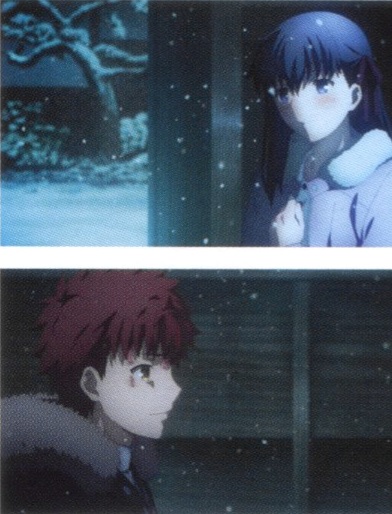
Kondo: I felt it was a very powerful song. I’m just afraid that if so much is narrated in Chapter 1, what will they do for Chapters 2 and 3…?
Nasu: It’ll be fine. I’m sure Kajiura will find a way!
All: (laughs)
Nasu: I feel like anime movies lately are more of a pursuit of pleasure. But with this film, I feel like this is what a Japanese movie should be: “A dark passion, but beautifully rendered.” I feel that [HF] may become a title that returns to the principle that film is “a combination of hard feelings and good feelings.” I felt “Hana no Uta” was outstanding in that it symbolized that principle. I could tell that even the theme song at the end of the finale understood what this story was about.
Kondo: Concerning work involving the theme song, I felt that the staff roll turned out well. Right when Nasu’s name comes up, the song goes into its interval break (no sound). That’s when the screen blacks out, and Nasu’s name comes in right as the song picks up again. That was a recurrence of what we did with the theme song “oblivious” to the movie the Garden of sinners: Chapter 1: Thanatos, I had a premonition when I heard the song – that I could time it right. So I kept adjusting it over and over.
Nasu: Now that you mention it, it feels like the number of people in the staff roll was rather small for a theatrical release.
Kondo: We work in-house. Whether it be Tales of Zestria the X or Katsugeki TOUKEN RANBU, the same staff are behind the production for them all. I hope everyone will look forward to the teamwork that we have built up.

Staff Message
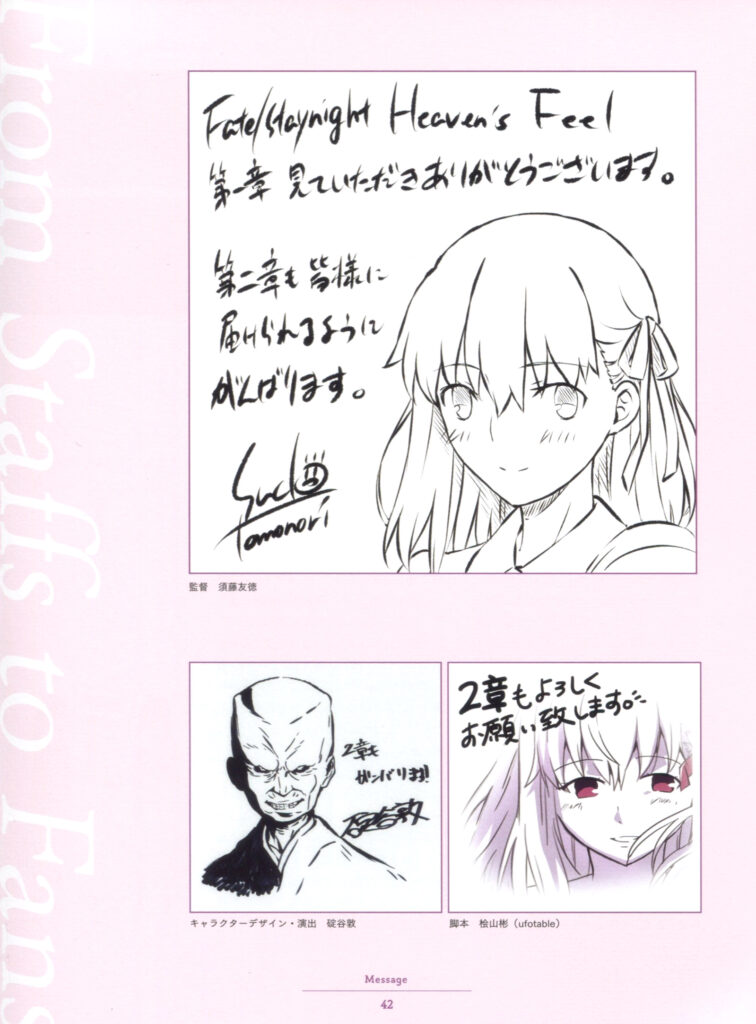
[Bottom Left] Character Design & Direction: Atsushi Ikariya “I will do my best on Chapter 2, too!”
[Bottom Right] Screenplay: Akira Hiyama “Please watch Chapter 2, too!”
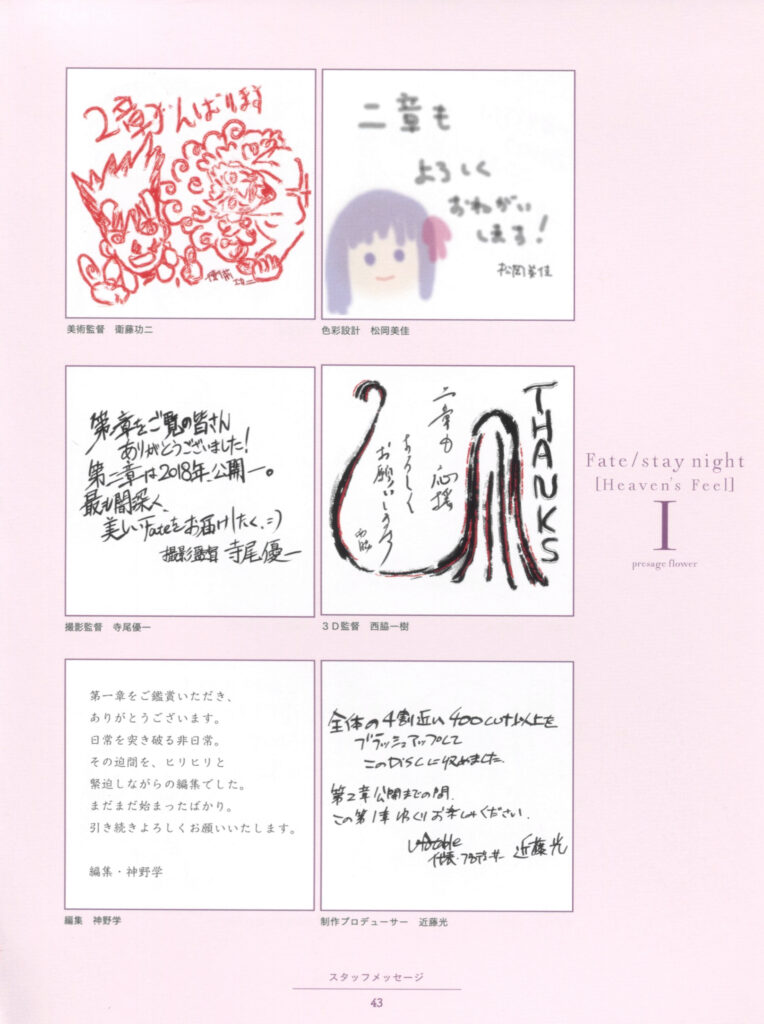
[Top Right] Color Setting: Mika Matsuoka “Please watch Chapter 2 too.”
[Middle Left] Director of Photography: Yuichi Terao “Thank you for watching Chatper 1! Chapter 2 will be released in 2018. I will bring you the darkest, yet most beautiful Fate.”
[Middle Right] 3D Director: Kazuki Nishiwaki “Please watch Chapter 2, too.”
[Bottom Left] Manabu Kamino “Thank you for watching. An extraordinariness that breaks ordinariness… I kept editing in such tense moments. But that’s just the beginning. Please continue watching.”
[Bottom Right] Animation Producer: Hikaru Kondo “We re-took more than 400 cuts, or 40% of the movie, for this disc. Please enjoy Chapter 1 while awaiting Chapter 2.”

[Top Right] Animation Director: Keita Shimizu “Please look forward to seeing Rider’s action.”
[Middle Left] Animation Director: Tetsuto Sato “Thank you for watching. I’ll do my best on Chapter 2.”
[Middle Right] Animation Director: Junya Kikuchi “Thank you for watching.”
[Bottom Left] Animation Director: Shun Yamaoka “Thank you!”
[Bottom Right] Animation Director: Koji Akiyama “Look forward to seeing Shirou getting beat up even more!”
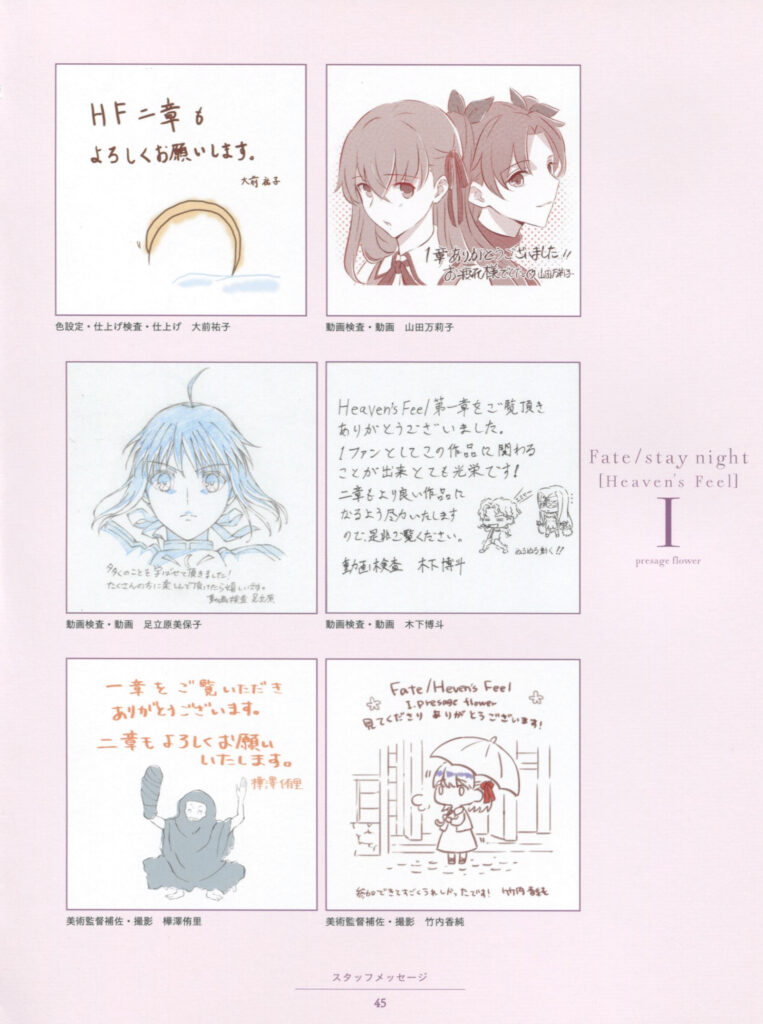
[Top Right] Inbetween Checker/Inbetweener: Mariko Yamada “Thank you for watching!!”
[Middle Left] Inbetween Checker/Inbetweener: Mihoko Adachi “I learned a lot from the movie. Hope many people will enjoy.”
[Middle Right] Inbetween Checker/Inbetweener: Hiroto Kinoshita “I am honored to be able to work on HF because I am a fan. I will do my best on Chapter 2.”
[Bottom Left] Assistant to Art Director/Photography: Yuri Kabasawa “Thank you for watching. Please watch Chapter 2, too.”
[Bottom Right] Assistant to Art Director/Photography: Kasumi Takeuchi “Thank you for watching! I’m glad I was able to participate!”
Untranslated Content


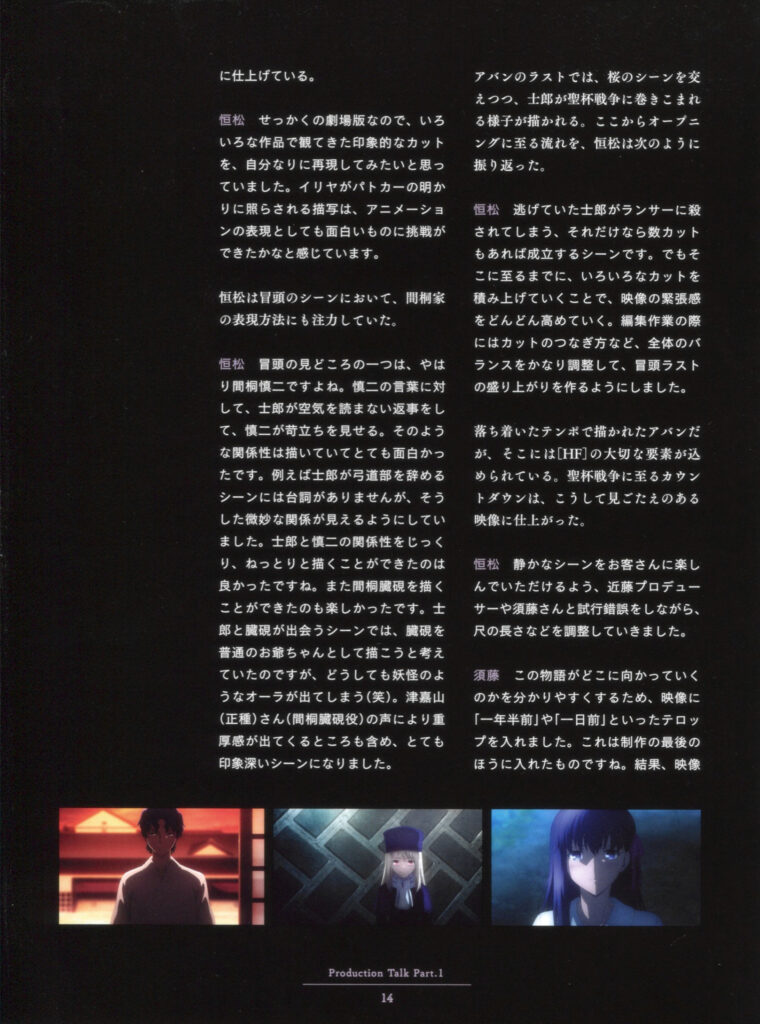


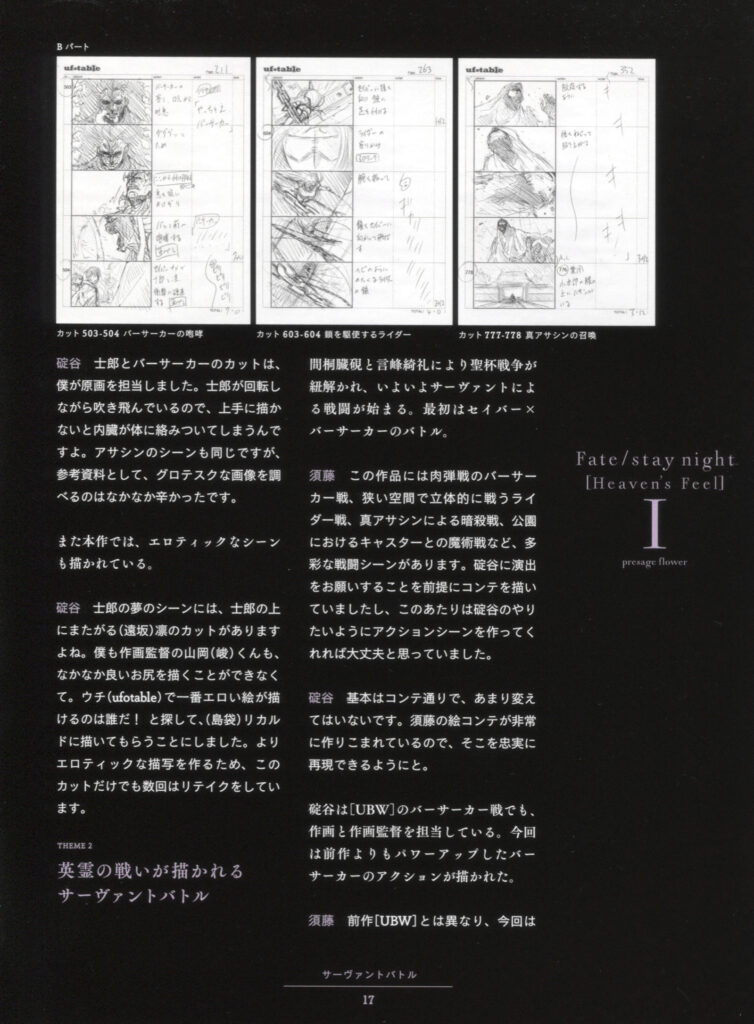

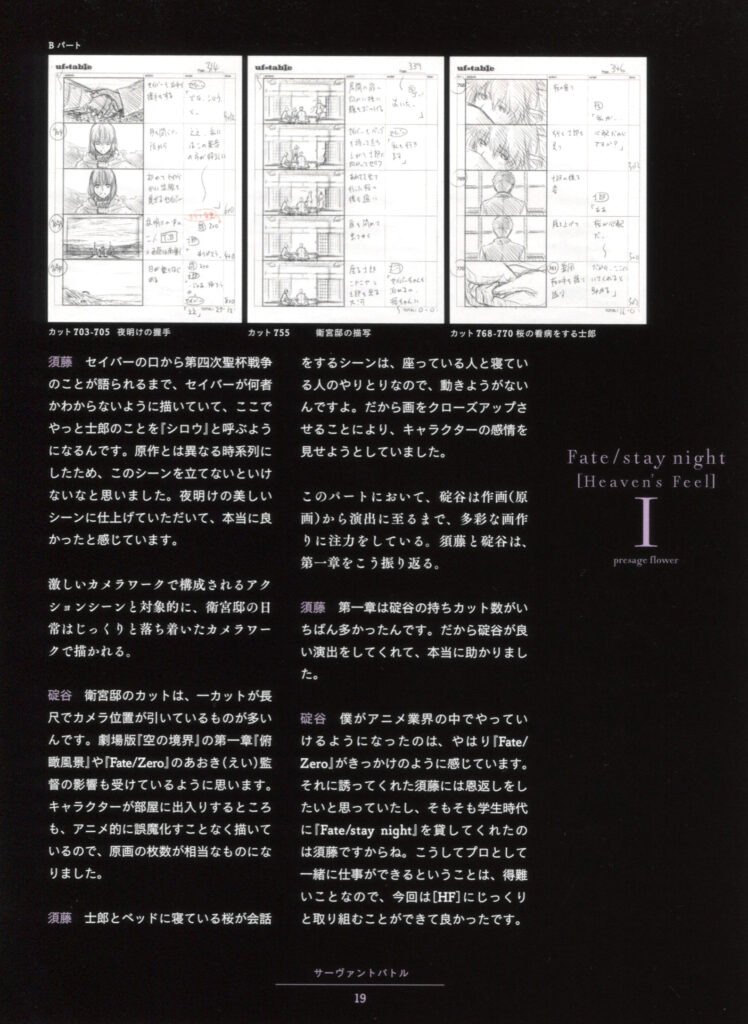
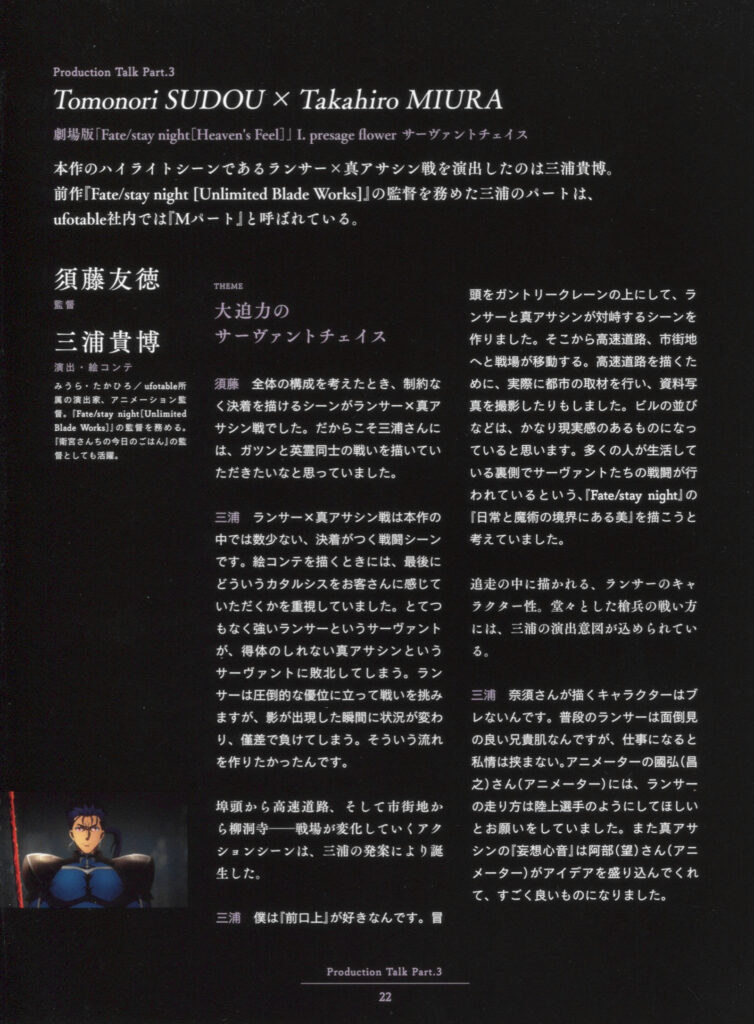


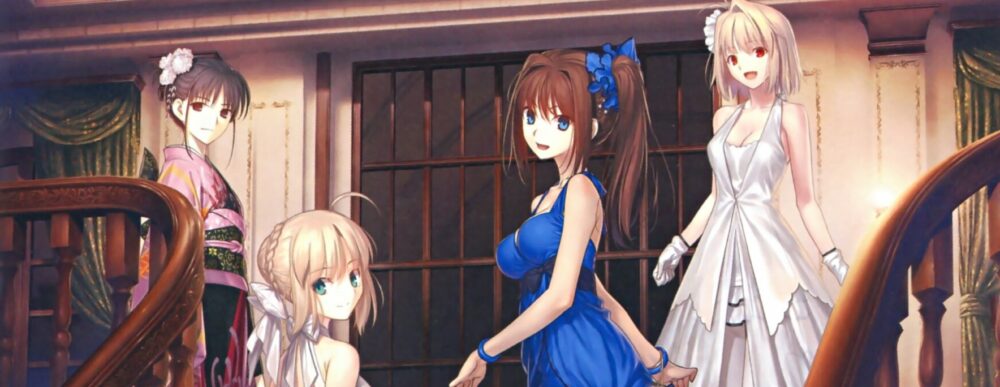
any plans to translate the untranslated content?
are we getting the translation for part 2 and 3 ?